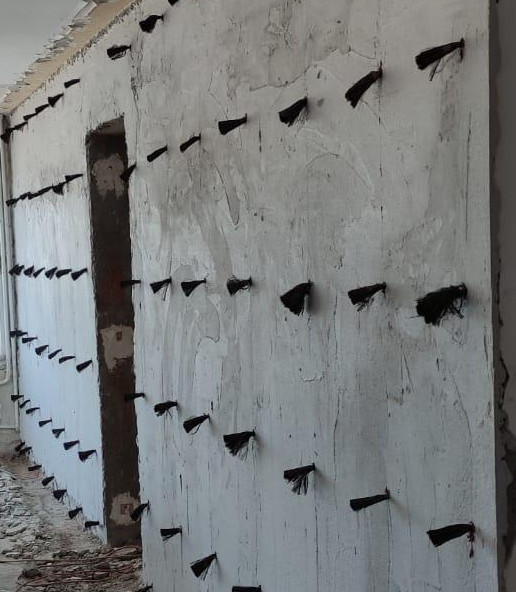Tags
In a recent strengthening project that we cooperated with our partner Omnis Kompozit in Turkiye: solidian ANTISEISMIC Flex Grid was applied as part of an FRCM (Fiber Reinforced Cementitious Matrix) system in a reinforced concrete building’s masonry walls. The objective of the intervention was to increase the load-bearing capacity of the existing walls, improve their crack resistance and provide enhanced seismic performance while maintaining a minimal additional thickness.
The solution was based on the combination of carbon textile reinforcement and a special cementitious mortar, forming a highly efficient composite layer. After the surface preparation, the solidian ANTISEISMIC Flex Grid was applied to the walls and embedded into the mortar matrix with the support of carbon connectors. This process created a continuous and durable reinforcement system that works synergistically with the existing concrete substrate.
Why solidian ANTISEISMIC Flex Grid?
Compared to traditional strengthening techniques, the carbon FRCM system offered several decisive advantages:
- Outstanding tensile strength of carbon fibers, providing high load capacity at very low thickness.
- Excellent crack distribution and control.
- Mineral mortar compatibility, ensuring good adhesion to the substrate.
- Corrosion-free solution, unlike steel meshes or rebars, enabling long service life and minimal maintenance.
- Lightweight and easy handling on site, reducing installation time and labor costs.
Installation process
The strengthening was carried out in several stages:
- Surface preparation of the existing reinforced concrete wall.
- Application of the first mortar layer to create an adhesive surface.
- Placement and alignment of solidian FLEX GRID Carbon on the surface.
- Installation of anchors, securing them to the reinforcement to ensure load transfer.
- Final mortar layer and surface finish, completely covering the reinforcement to create a durable and smooth surface.
With solidian ANTISEISMIC Flex Grid, the reinforced concrete walls achieved a significant improvement in structural safety and resilience. The strengthening layer remained thin and unobtrusive, which was particularly important for preserving the usable space inside the building. The system provided both structural efficiency and durability, making it an excellent alternative to conventional steel-based retrofitting methods.
This project once again highlights how solidian reinforcement solutions enable innovative and sustainable approaches in modern construction and renovation projects. By combining high-performance materials with easy installation and long service life, solidian ANTISEISMIC Flex Grid proves to be a reliable choice for seismic retrofitting and structural upgrading in reinforced concrete structures.





